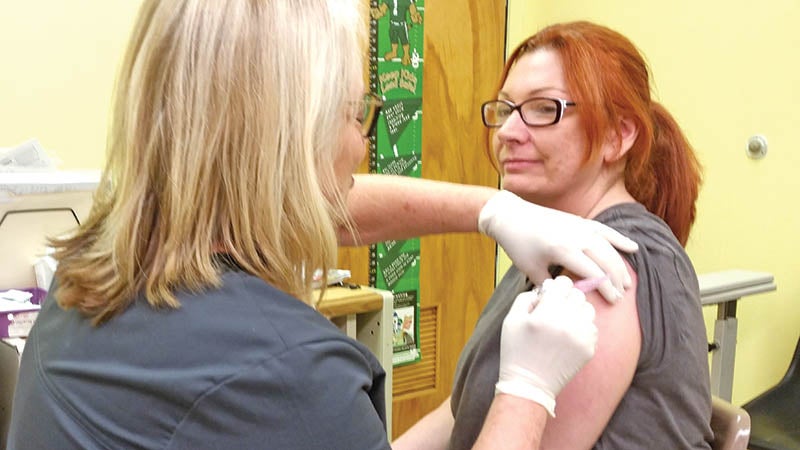Lawrence County continues to battle hepatitis A
Published 1:20 pm Friday, August 10, 2018

- The Tribune/Mark Shaffer Stephanie Barnett, the Lawrence County Health Department vaccine coordinator, gives a hepatitis A vaccine shot to Gina Boggs, the health department’s epidemiologist, on Thursday afternoon. Boggs recently started working at the health department and needed the vaccination.
The Lawrence County Health Department is continuing to fight a rising number of cases of hepatitis A as the county now has 48 cases. In June, the number of cases was 20.
“The cases are increasing and increasing and increasing,” said Georgia Dillion, the county health commissioner, adding that Lawrence County has the highest number of cases in the state of Ohio. “We are targeting the population that needs to be targeted, which is mainly people who are in the drug population.”
So, the health department is giving vaccinations and information to people in jail, in drug rehabilitation programs or are homeless in an effort to get high-risk groups vaccinated.
Dillion said they have seen an increase of cases in Proctorville and Chesapeake.
“We are monitoring every case and trying to get all their contacts in,” she said.
Dillion said that while the state is not mandating that everyone get a hepatitis A vaccination, it is a good idea to get one.
“The vaccines are in the area. If you have insurance, go to a pharmacy,” she said. “If your insurance doesn’t cover it or the co-pay is too high, you are always welcome to come here. We do walk-in clinics everyday for people who are uninsured or underinsured.”
The Lawrence County Health Department is doing hepatitis A vaccination shots from 9-11 a.m. or 1-3 p.m., Monday-Friday. The office is in the same location that it has been, 2122 S 8th St. in Ironton. For those who have insurance but can’t afford their deductible, there is a $10 charge for the 317 vaccine, which the Center for Disease Control recommends as most effective. A booster shot is required in six months.
Hepatitis A is a viral infection of the liver that can cause loss of appetite, nausea, tiredness, fever, stomach pain, brown colored urine, and light-colored stools. Yellowing of the skin or eyes may also appear. People may have some or none of these symptoms. It could take up to 50 days after being exposed to the virus for someone to become ill but most people experience symptoms within 28-30 days after being exposed.
Hepatitis A usually spreads when a person unknowingly ingests the virus from objects, food, or drinks contaminated by small, undetected amounts of stool from an infected person. The virus spreads when an infected person does not wash his/her hands adequately after using the toilet or engages in behaviors that increase risk of infection. Hand sanitizer does not kill hepatitis A.





